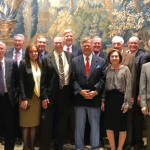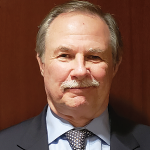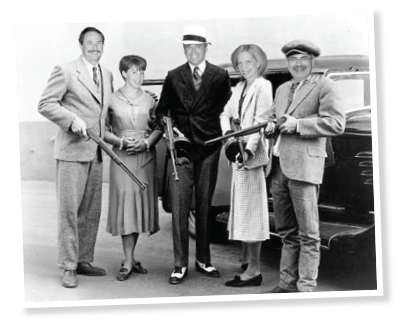
Mark Andrejeski, Theresa Fitzgerald, David Wofsy, MD, Peggy Crow, MD, and Neal Birnbaum, MD
In March 1987, Mark Andrejeski moved from Columbus, Ohio, to Atlanta to lead a brand-new organization: the American Rheumatism Association (ARA). The professional association of rheumatologists had separated from the Arthritis Foundation 15 months earlier.
“Initially, I was just trying to make sure the organization survived,” says Mr. Andrejeski, who studied business management and economics in college. After graduation in 1973, he worked in educational programming and fundraising for the American Heart Association, known for its high-profile public education programs. The ARA had a decidedly lower profile.
“I didn’t know what the American Rheumatism Association did when first contacted about the job,” Mr. Andrejeski says. “Rheumatology was relatively unknown back then. One of the first membership surveys we did told us that increasing awareness of what a rheumatologist does was a high priority.”
Mr. Andrejeski, who will retire as executive vice president on May 31, got to work. In 1989, the ARA changed its name to the American College of Rheumatology (ACR). He worked with volunteer leaders to expand medical education and advocacy, and create rheumatology practice standards and ethical principles. He built a marketing program, expanded government affairs and standardized the ACR’s contractual relationships with corporate sponsors. He preferred to lead from backstage while volunteers crafted the vision and enjoyed the spotlight.
“My job has always been to try to see the big picture, to understand where the organization was, where it was going and what steps we needed to take to keep moving forward. I was always fortunate to have presidents, Executive Committees and Boards of Directors who had a clear vision. Once I had their vision in mind, I could make it work,” he says.
Clear Vision, Strong Leader
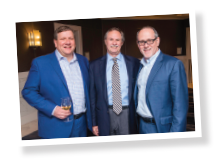
Eric Ruderman, MD,
Mark Andrejeski, and
Kenneth Saag, MD, MSc
ACR Past President Joseph D. Croft Jr., MD, now retired and living in Bethesda, Md., first met Mr. Andrejeski at a 1987 leadership dinner.
“The hope then was that Mark would continue to hold this position for many years to come,” says Dr. Croft. “During Mark’s tenure, the commitments of the organization have dramatically expanded in every phase of its mission, namely advancing rheumatology.”
Mr. Andrejeski’s careful planning and oversight shepherded the ACR though dramatic changes, says Dr. Croft.
“Our fiscal status has been meticulously managed by Mark, his staff and the board, and the ACR has achieved financial success of significant proportions,” says Dr. Croft. “Our mission and overall success have advanced at every level during Mark’s tenure, and his leadership, clear and creative vision, work ethic and commitment to the ACR have been instrumental in achieving those successes.”
Jane S. Diamond, MPH, managing editor of Arthritis & Rheumatology, was on staff in 1987 when Mr. Andrejeski arrived. “There was an immediate sense of confidence about the future of the organization, and he delivered on that,” says Ms. Diamond. “The fact that we still feel so confident about the future of the ACR without Mark is also a testament to him.”
Mr. Andrejeski takes pride in the achievements of the people who work with him. “I have had five different people on my staff over the years who have gone on to run national associations. That, in terms of my contribution to my own profession, is something I am really proud of,” he says.
Steven Echard, IOM, CAE, now chief executive officer of the American Association for the Study of Liver Diseases (AASLD) in Alexandria, Va., is one of those recruits. He joined the ACR staff at age 25, eventually becoming the executive director of the Rheumatology Research Foundation, a position he held from 2005–’14. He praises Mr. Andrejeski’s “ability to manage the governing process and assist volunteer leadership in making sound decisions. The financial success of the organization over the past 30-plus years is a direct result of his leadership and sound business acumen.”
Mr. Andrejeski advised Mr. Echard on shaping his career in association management, often during regular one-on-one lunches.
“We always had great discussions about his theories of management and rationale for organization and staff decisions,” says Mr. Echard. “I will forever be grateful for the ACR’s support, and for Mark’s personal support, for me to achieve these goals.”
‘My job has always been to try & see the big picture, to understand where the organization was, where it was going & what steps we needed to take to keep moving forward.’ —Mark Andrejeski
Rheumatology’s Recognition
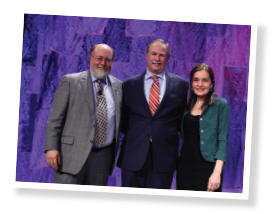
David Daikh, MD, PhD,
Mark Andrejeski, and
Paula Marchetta, MD, MBA
When Mr. Andrejeski started his tenure, rheumatologists were considered internists by the U.S. Health Care Finance Administration (HCFA), the precursor to the Centers for Medicare and Medicaid Services (CMS). However, rheumatologists treated patients with complex, chronic diseases. These patients needed repeat office visits and multiple tests and therapies.
“So the HCFA flagged rheumatologists as outliers, because they were doing way more to treat their patients than other internists,” says Mr. Andrejeski. Reimbursement claims were often challenged. “So we had to go through a process to prove who we were and what we do to the U.S. government.” In 1990, HCFA recognized rheumatology as a separate subspecialty.
He cites past ACR presidents Bill Kelley, Paulding Phelps, Jack Stobo, Ira Goldstein, Steve Malawista and John Sergent as early mentors who helped him understand what makes rheumatology unique.
“Rheumatologists are problem solvers. They like puzzles and challenges,” says Mr. Andrejeski. “I’m like that, too. So this job was a good fit for what I am like as an individual and rheumatologists’ phenotype as physicians.”
ACR Past President David Wofsy, MD, MACR, Distinguished Professor of Medicine and Microbiology/Immunology at the University of California San Francisco School of Medicine, calls Mr. Andrejeski “the key architect and consistent driving force responsible” for the ACR’s growth, financial security and political clout.
“The spirit of common purpose and mutual respect that Mark has fostered among the diverse ACR membership is rare among medical subspecialties, and he has enabled the ACR to dramatically increase its impact,” says Dr. Wofsy. “He’s guided the ACR with unwavering commitment to principle, including in times when the temptation to abandon principle for short-term gain was very tempting.”
Exciting New Era
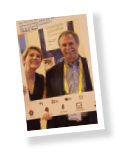
Julie Anderson, CAE, and Mark Andrejeski at EULAR
One of those times was the late ’90s when the first biologic therapies for rheumatoid arthritis were approved. Drug manufacturers launched advertising campaigns with commercials urging patients to “see your rheumatologist” about these new therapies. Industry came calling with ideas for “how we could work together.” The ACR created its Corporate Roundtable as a response, with clear, contractual relationships with industry partners. It also tightened regulations for industry activities at the Annual Meeting and other educational settings.
Biologics changed rheumatology in dramatic ways, Mr. Andrejeski says, “not only the way we treated patients, but also, from a government standpoint, rheumatology became a very high-expense item specialty. We started getting pushback from payers’ systems again, because rheumatologists were such high users of biological products.”
“The government responded by hitting our members with reduced reimbursements. The impact was significant. The ACR’s government affairs staff and volunteer advocacy became even more important,” he says.
Unflappable in a Crisis
Mr. Andrejeski’s “unflappable” leadership through challenging times is his hallmark, says Michael E. Weinblatt, MD, professor of medicine, Harvard Medical School, co-
director of clinical rheumatology at Brigham and Women’s Hospital, Boston, and ACR past president, 2000–2001.
He recalls when the Sept. 11, 2001, terrorist attacks created global fear about air travel that jeopardized the ACR/ARHP Annual Meeting in San Francisco scheduled for that November.
“The Annual Meeting is a huge source of revenue. Mark and I had to make a decision about whether or not to print the syllabus,” says Dr. Weinblatt. “We decided to go forward and hold the meeting, even though some countries would not let their rheumatologists come. We transferred cash to Wells Fargo in San Francisco just in case we needed it to get staff and ACR members out of the city on chartered buses. Mark was, and is, a true leader. He wanted to be sure everyone was safe.”
Mary K. Crow, MD, physician in chief, chair of medicine and chief of rheumatology at Hospital for Special Surgery in New York City, recalls meeting Mr. Andrejeski about 20 years ago at a dinner with several rheumatologists. She realized she was being recruited to volunteer.
“He had the knack of identifying rheumatologists with potential and encouraging them to get involved,” says Dr. Crow, who went on to chair the Annual Meeting Planning Committee and serve as ACR president. “Mark really understands the kind of people the ACR needs and the unique skills we have. However, he has a gentle touch. He allows volunteers to take on leadership positions, but he would always be by your side, supporting you and taking the organization in the right direction. Mark has a sense of everything that’s going on, and weighs in with his opinion, even if it’s a different opinion. He’s always respectful and collegial.”
Mr. Andrejeski also recruits talented staff and gives them the freedom to do their jobs, she says. One of these is Mary Wheatley, CAE, IOM, executive director of the Foundation.
“Mark is great at recognizing potential in the next generation of leaders, cultivating that potential and then pushing them to the next level. I’ve seen it—and been it!—happen with staff and volunteers. It’s incredible to watch,” says Ms. Wheatley. “Mark’s institutional memory is incredible. Not only does he remember everything, but he’s a gifted storyteller. He places emphasis where needed to make his point and help his audience understand the significance of the events. I’ve often wished we could record his talks at board meetings for posterity.”
Proudest Achievements
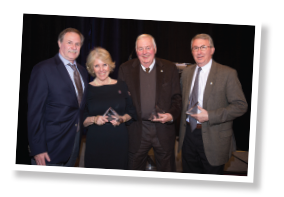
Mark Andrejeski,
Tobé Malawista,
Arthur Weaver, MD, and Stanley Cohen, MD
One of Mr. Andrejeski’s proudest achievements was increasing the pipeline of rheumatology trainees, which had dipped in the ’90s. Young physicians did not want to practice in a field that had few therapies available to help their patients.
“Biologics changed all that. All of a sudden, rheumatologists became the leaders in biological therapy. We had more interest from trainees,” he says. “Our leaders at the time had the wisdom to go to industry and say, ‘There is a dearth of rheumatologists. If you want your therapies to be utilized to help the most patients, you’ll need more rheumatologists.’” The Foundation funded its first rheumatology fellowships in 2002, and in 2019, there will be close to 250 rheumatology trainees starting fellowships.
Mr. Andrejeski also cites the launch of the Rheumatology Informatics System for Effectiveness (RISE) registry as a source of pride (see “The RISE Registry,” p. 27). “Rheumatologists need to record and measure what is going on with patient progress. That’s a message I want to send: Measure, measure, measure. RISE hasn’t yet scratched the surface of its possibilities, but it is a powerful tool. A rheumatologist and friend, Antony Rosen, MD, from John Hopkins once said to me, ‘Man, as a species, loves tools.’ We have to figure out how to benefit the most from this incredible tool.”
Retirement Plans
One of Mr. Andrejeski’s longtime staff members, Ron Olejko, retired last year after working for the ACR for more than 40 years—since 1975. He remembers the concern many had that the new association wouldn’t survive. Instead, it thrived under Mr. Andrejeski’s watch.
“Due to Mark’s financial acumen, the ACR is now financially stable and a major supporter of rheumatology research. Among Mark’s many talents is his ability to hire the best people for the job and then allow them the freedom to excel in those jobs,” says Mr. Olejko. But the Ohio native and Cleveland Browns fan adds, “Mark does have one major flaw: He’s a Steelers fan.”
What will Mr. Andrejeski do in retirement? He has no idea.
“I’m looking forward to finding out. I just want to figure it out as it happens. I’ve traveled to so many great places while I have worked here, so I don’t even know if travel is that high on my list,” he says. “I’m going to try to get back into my golf game. That’s one of the reasons I wanted to move here to Atlanta. The weather allows you to play golf so much of the year.”
Why retire now? It’s the right time,
he says.
“People always say, ‘If you look at yourself in the mirror and say, ‘It’s time to retire,’ you know it’s time. You just know.”
Susan Bernstein is a freelance medical journalist based in Atlanta.
